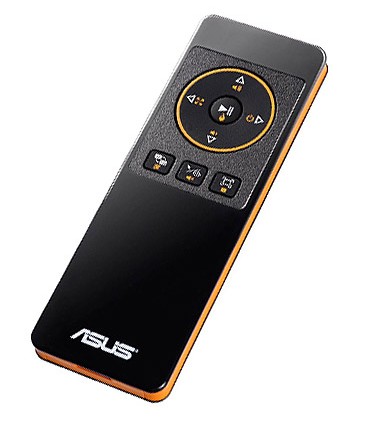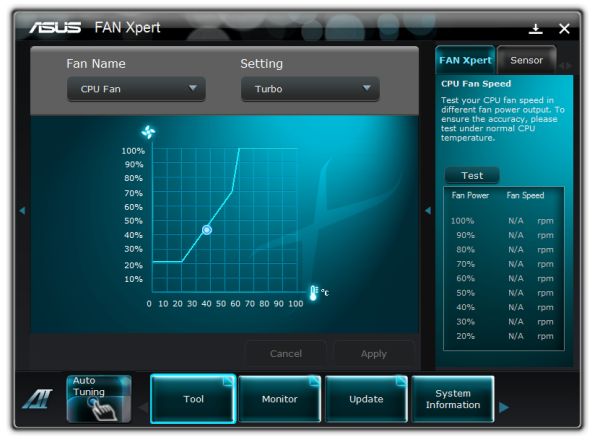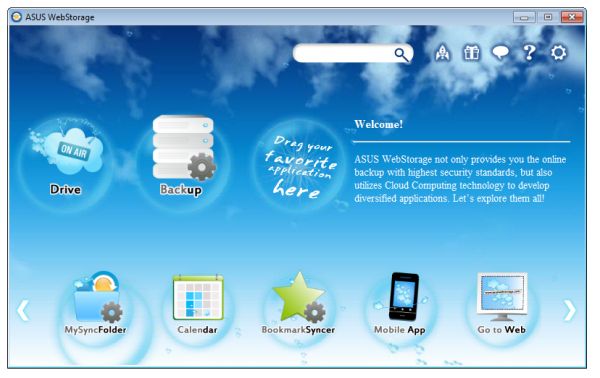ASUS F1A75-I Deluxe Review – Llano and Mini-ITX
by Ian Cutress on October 1, 2011 5:30 PM EST- Posted in
- Motherboards
- Asus
- A75
Board Features
| ASUS F1A75-I Deluxe | |
| Market Segment | Small Form Factor |
| Size | Mini-ITX |
| CPU Interface | FM1 |
| CPU Support | Desktop Llano |
| Chipset | A75 |
| Base Clock Frequency | 100 MHz by Default, 90 to 300 MHz in 1 MHz increments |
| DDR3 Memory Speed | 1333 MHz by Default, 800 MHz to 1866 MHz supported |
| Core Voltage | 0.800 V to 1.700 V in 0.0125V increaments |
| CPU Clock Multiplier | CPU Dependent, Fixed unless Black Edition processors used |
| DRAM Voltage | 1.35 V to 2.30 V in 0.1 V increments |
| DRAM Command Rate | 1 or 2 |
| Memory Slots |
Two DDR3-DIMM Maximum 8 GB, Non-ECC Unbuffered 800 MHz to 1866 MHz selectable |
| Expansion Slots |
1 x PCIe x16 1 x mini-PCIe |
| Onboard SATA/RAID |
4 x SATA 6 Gbps (RAID 0, 1, 10) 1 x eSATA 6 Gbps |
| Onboard |
4 x SATA 6 Gbps 2 x Fan Headers 1 x USB 2.0 header 1 x USB 3.0 header 1 x S/PDIF Out header 1 x Front Panel Connector 1 x Front Panel Audio Connector 1 x MemOK! Button 1 x Clear CMOS Jumper 1 x Wireless 802.11 b/g/n |
| Onboard LAN | RealTek RTL8111E Gigabit Fast Ethernet Controller |
| Onboard Audio |
Realtek ALC892 8-Ch High Definition audio CODEC DTS Surround Sensation UltraPC |
| Power Connectors |
1 x 24-pin ATX 1 x 4-pin 12V |
| Fan Headers |
1 x CPU (4-pin) 1 x CHA (4-pin) |
| IO Panel |
2 x USB 3.0 Ports 4 x USB 2.0 Ports 1 x PS/2 Port 1 x Gigabit Ethernet 2 x Antenna 1 x Clear CMOS button 1 x Optical SPDIF output 3 x Audio Jacks HDMI/DisplayPort/DVI-D Video Outputs 1 x eSATA 6Gbps Bluetooth Module 1 x Optical SPDIF output |
| BIOS Version | 07/18/2011 |
| Warranty Period | 3 Years |
ASUS have used the Realtek NIC/Audio combo for this board. We are not short of USB ports, especially on the back panel for such a small board. As mentioned before, I would have preferred another fan header, but with such a large retention bracket for the processor, there is not much space to fit on much else unless ASUS built upwards for the wireless card.
In The Box
User Manual
I/O Shield
2 x Locking SATA 6Gbps
2 x Wifi Antenna(s)
1 x Remote Controller
1 x USB Wireless Adapter
The additions to this board are not that substantial – there is no additional USB 3.0 bracket or a couple more SATA cables. Instead, an extra bit of kit I have never seen before has been added – the remote controller.


I am not sure if this is ASUS made, or a licensed bit of kit, but using the USB wireless adapter, the user can use the remote controller for moving the cursor around or turn it upside down for the keyboard. Rather than use any fancy gyroscope detection, imagine just moving the mouse using the arrow keys on the keyboard with the mouse moving at constant speed – that’s what using this tool is like. When I have been using the keyboard, from three feet away from the wireless connector, only about 80% of the key presses go through if I take my time to type – less if I type at my normal pace. The controller itself is not ergonomic enough to fit easily to hand, and does not feel robust enough to take the daily strains that a standard controller might take. The keyboard layout is a bit odd from the standard QWERTY, with the I and K keys being on different lines. Ultimately, I could only see myself using this bit of kit for DVD menus or selections.
Update: I asked ASUS the reasoning of such a bit of kit. They have told me that they went this route instead of a general WMCE remote, and users have specified text input as a main addition required. The key fitting for ASUS was for it to have similar dimensions to a smart phone, and make it easy to hold with palms and using thumbs to type.
The antenna that come with the package are substantial in size and are also magnetized at one end, allowing the user to connect them together to hang in one place, or have a board to magnetize them to. Perhaps best to keep them away from any mechanical hard drives, though.
Software
The installation disc that comes with the board uses ASUS’ easy style installation for both drivers and software. Previously, we have encountered ASUS partnering with Norton to provide a version on the CD – this is still available. However, this time ASUS have also partnered with Google to provide a build of Chrome 11, which is a more than welcome bit of software.
The installation itself is straight forward – select ‘Install All’ and you can select/deselect certain software for an automatic installation, with automatic reboots as necessary. One point of difference I found was in the estimated time to completion – with the drivers, the software predicted 33 minute to completion, whereas it only took 10 minutes including restarts. Similarly with the software, 34 minutes were predicted, but it only took seven.
The software itself focuses around three packages – ASUS Suite II, which we have encountered before on previous boards; ASUS WebStorage, a tool for file and folder distribution and synchronization within the ASUS cloud; and ASUS Vibe, a radio/game utility.
ASUS Suite II
As I have covered with the P8Z68-V Pro and Brendan has with the P8P67, the Suite II software covers a lot of the motherboard functionality in one easy to use package. Here is where the user can set an overclock, define fan profiles, adjust power saving settings, monitor onboard sensors, and update the BIOS.
As we have covered the software before, I will briefly state that it all works from what I tested, including the fan settings which offers user manipulation of fan speed gradients. The only issue I have with it is that overclock settings are not saved between reboots – either in the form of BIOS changes, or reapplied when booting back into the operating system.
ASUS WebStorage
The new bit of software in the ASUS arsenal is WebStorage.
By creating an account online, the user gets a small amount of free storage (2GB) which they can use to synchronize folders to the cloud. Users can upgrade to unlimited storage for a monthly fee, and share links to files. Through the mobile app, users can sync music with the cloud as well. The full online site can be found at https://www.asuswebstorage.com/navigate/features/.
Ultimately, this service is offered with or without the purchase of the motherboard, but the software looks as if it is now coming with future products.
ASUS Vibe
I touched on ASUS Vibe previously in my look at the E35M1-I Deluxe – Vibe is a simple piece of software which provides one click access to music stations, radio stations and game demos. The radio stations are amazingly synced to your location - I got links to an array of BBC radio stations as I am in the UK. They are all run within the software window itself, but the games require downloading.



















51 Comments
View All Comments
bijeshn - Monday, October 3, 2011 - link
How good is the onboard wireless 802.11 b/g/n implementation on this board?mitcoes - Monday, October 3, 2011 - link
I do think this devices are ATOM competence.As they provide a remote control, pobrably to be used as set top boxrs attached to TVs.
Google TV, Android, Desktop Linux, and even Hackintosh are the OSs that will run better.
MS WOS is for AMD Phenom and bulldozers or iNTEL I3 to i9 not for Llano or ATOM.
At this kind of devices nix works far more better than MS WOS.
Death666Angel - Monday, October 3, 2011 - link
And why exactly is that?Also, can Linux play commercial blurays, yet? Can I legally install MacOS on a non-Apple PC? Does Google TV or Android have an easy installation routine and easy navigation on a PC?
CharonPDX - Monday, October 3, 2011 - link
*SEEMS* good. But to use a USB dongle, rather than either CIR (standard WinMCE protocol) or Bluetooth seems dopey. Heck, I'd like to see it use CIR for the WinMCE side, and Bluetooth for the keyboard/mouse half...MobiusStrip - Monday, October 3, 2011 - link
When these babies have Thunderbolt, they're gonna rock.justniz - Tuesday, October 4, 2011 - link
Please stop using 1024x768 for gaming benchmarks.I'm pretty sure practically no gamer uses a 4:3 monitor or plays in such a low resolution.
Whats wrong with 1920x1080?
Furthermore with any modern GPU, at such a low res th'eres a strong chance all you're maxing out is the DMA bandwidth to/from the GPU, not its rendering muscles.
mariush - Tuesday, October 4, 2011 - link
Actually a better resolution would be 1280x720.Since it's 16:9, various wide format monitors would not distort the image and since it's HDMI native TVs would probably upscale it just fine to 1920x1080.
Such resolution is suitable to test on board video cards (and cpu embedded video cards) - with higher resolutions you may get into memory bandwidth issues and then you're not really testing the gpu anymore..
ddrum2000 - Wednesday, October 5, 2011 - link
I agree with many that this review is a bit flawed. I'd like to see this board compared to the AsRock A75M-ITX and the Zotac A75ITX-A-E . In addition the A8-3850 is not the best HTPC CPU because of the high TDP. The A8-3800 with a 65 W TDP (I think) would be a much better HTPC comparison. Thanks to the person who said that the Scythe Big Shuriken will not fit as the was the cooler I was planning to use. Thoughts?AnnihilatorX - Thursday, October 6, 2011 - link
I am looking for a power efficient mini-ITX buildI was hoping to see some power consumption benchmark :/
Soulkeeper - Sunday, October 16, 2011 - link
I think your motherboard review would be improved if you included the following:A table containing the bios min/max for all voltage, fsb, mult, etc. settings
Tomshardware does this when they compare motherboards and it's really helpful :)
Also I can't help but wonder if the wifi can be removed and replaced with a mSATA/'miniPCIe' SSD and used as the boot drive.
Thank you